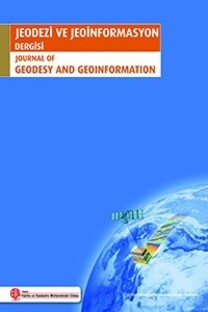Minimum çakışan yersel lazer taramalarının birleştirmesi için fotogrametrik özellikler
Günümüzde, insan yapımı binaların 3 Boyutlu 3B modellemesine olan ilgi ve talep veri toplama sistemlerindeki gelişmeler ve büyüyen potansiyel uygulama aralığı ile birlikte arttı. Mevcut durumda, 3B veriler iki teknoloji ile sağlanmaktadır: fotogrametri ve lazer taraması. Lazer taramalarının toplanması ve islenmesinde zaman kaybı söz konusudur. Bütün bir 3B model elde etmek için birçok lazer taraması gerekmektedir. Her bir lazer taraması ayrı koordinat sistemlerinde olduğu için; 3B modeller ancak bu farklı koordinatlardaki lazer tamamlarının bir araya dizilmesi ile mümkündür. Bu dizilim “birleştirme” olarak bilinir. Birçok birleştirme teknikleri doğru 3B model için toplanan lazer taramaları arasında büyük oranda çakışma ister. Bu araştırmanın temel amacı fotogrametrik veri kullanarak lazer taramaları arasındaki büyük oranda istenilen çakışmadan kaçınmaktır. Birleştirme tekniklerinde genellikle noktalar kullanarak lazer taramaları arasındaki ilişki bulunur. Bu önerilen araştırmada düzlemsel ve doğrusal özellikler çıkarılmış ve kullanılmıştır. Son olarak, nitel ve nicel kalite kontrol yöntemleri önerilen birleştirme metodu sonucunu analiz etmek için yapılmıştır.
Anahtar Kelimeler:
Yersel lazer tarayıcı, Yersel fotogrametri, Birleştirme, Özellik çıkarma
Photogrammetric features for the registration of terrestrial laser scans with minimum overlap
The interest and demand for 3 Dimensional 3D documentation of man-made structures have increased with the continuous improvement in data acquisition systems and the expanding range of potential applications. Currently, 3D data can be obtained through two technologies: photogrammetry and laser scanning. In spite of the proven quality of static laser scanning, the collection and processing of laser scans is a time consuming process and the derivation of complete 3D models requires multiple scans with each scan having its own coordinate system. Therefore, the different scans should be aligned in a common coordinate system. This alignment process is known as “registration”. Current registration techniques require large overlap area between the collected scans in order to obtain reliable estimation of the transformation parameters relating these scans. The main objective of this research is to avoid the requirement of large overlap areas among the laser scans using photogrammetric data for the registration process. Registration methods generally use points as primitives to relate the different laser scans. In this research, photogrammetric linear and planar features are used for the proposed registration method. Finally, qualitative and quantitative quality control measures are proposed for analyzing the result of the proposed registration method
___
- Al-Durgham M. (2007), Alternative Methodologies for the Quality Control of LiDAR Systems. Yüksek Lisans Tezi, Department of Geomatics Engineering, University of Calgary, Kanada, ss. 66-68.
- Al-Durgham M., Detchev I., Habib A., (2011), Analysis of Two Triangle-Based Multi-Surface Registration Algorithms of Irregular Point Clouds, ISPRS Workshop Laser Scanning 2011, XXXVIII-5/W12, Calgary, Kanada, 29-31 Ağustos, 2011.
- Al-Manasir K., Fraser C. S., (2006), Automatic Registration of Terrestrial Laser Scanner Data via Imagery. The International Archives of the Photogrammetry Remote Sensing and Spatial Information Sciences(IAPRS), Dresden 25-27 Eylül, 35(5), ss. 26-31.
- Al-Ruzouq R., (2004), Semi-Automatic Registration of Multi-Source Satellite Imagery with Varying Geometric Resolutions, Doktora Tezi, Department of Geomatics Engineering, University of Calgary, Kanada, ss.10-24.
- Balzani M., Pellegrinelli A., Perfetti N., Russo P., Uccelli F., Tralli S., (2002), Cyrax™2500 laser scanner and G.P.S. operational flexibility: from detailed close range surveying, to urbanscale surveying. Proceedings of International Workshop on Scanning for Cultural Heritage Recording – Complementing or Replacing Photogrammetry' nin içinde, Corfu, Yunanistan, 1 – 2 Eylül.
- Besl P. J., McKay N. D., (1992), A method for registration of 3-D shapes, IEEE Transactions on Pattern Analysis and Machine Intelligence, 14(2), ss. 239–256, doi: 10.1109/34.121791.
- Chen Y., Medioni G., (1992), Object modeling by registration of multiple range images, Image and Vision Computing 10(3), ss. 145-155, doi: 10.1016/0262-8856(92)90066-C.
- Dold C., Brenner C., (2006), Registration of Terrestrial Laser Scanning Data Using Planar Patches and Image Data, IAPRS Volume XXXVI, Part 5, Dresden 25-27 Eylül 2006.
- Habib A., Ghanma M. S., Tait M., (2004), Integration of LIDAR and Photogrammetry for Close Range Applications, XXth ISPRS Congress: Proceedings of Commission V, 7 Temmuz 2004, Türkiye.
- Habib A., Bang K. I., Aldelgawy M., Shin S. W., Kim K. O., (2007), Integration of Photogrammetric and LIDAR Data in a Multi- Primitive Triangulation Procedure, Conf. American Society Photogrammetry Remote Sensing Conference, Tampa, Florida, Mayıs 7-11 2007.
- Habib A., Kersting A. P., Ruifanga Z., Al-Durgham M., Kim C., and Lee D. C., (2008), Lidar Strip Adjustment Using Conjugate Linear Features in Overlapping Stripts, The International Archives of the Photogrammetry, Remote Sensing and Spatial Information Sciences, XXXVII. Part B1, Beijing 2008, ss. 386-390.
- Habib A., Kwak E., Al-Durgham M., (2011), Model-Based Automatic 3D Building Model Generation by Integrating LiDAR and Aerial Images, Archives of Photogrammetry, Cartography and Remote Sensing, 22, ss. 187-200
- Kersting A. P. B., (2012), Quality Assurance of Multi-Sensor Systems, Doktora Tezi, Department of Geomatics Engineering, University of Calgary, Kanada, ss. 15-160.
- Lari Z., Habib A., Kwak E., (2011), An Adaptive Approach for Segmentation of 3D Laser Point Cloud, ISPRS Workshop Laser Scanning 2011, Calgary, Kanada, 29 – 31 Ağustos 2011.
- Lari Z., Habib A., (2012), A new approach for segmentation of multi-resolution and multi-platform LiDAR data, Proceedings of Global Geospatial Conference , Québec City, Kanada, 14-17 Mayıs 2012.
- Renaudin E., Habib A., and Kersting A. P., (2011), Featured-Based Registration of Terrestrial Laser Scans with Minimum Overlap Using Photogrammetric Data. ETRI Journal, 33(4), ss. 517- 527, doi: 10.4218/etrij.11.1610.0006.
- ISSN: 2147-1339
- Yayın Aralığı: Yılda 2 Sayı
- Başlangıç: 2012
- Yayıncı: TMMOB Harita ve Kadastro Mühendisleri Odası
Sayıdaki Diğer Makaleler
Minimum çakışan yersel lazer taramalarının birleştirmesi için fotogrametrik özellikler
